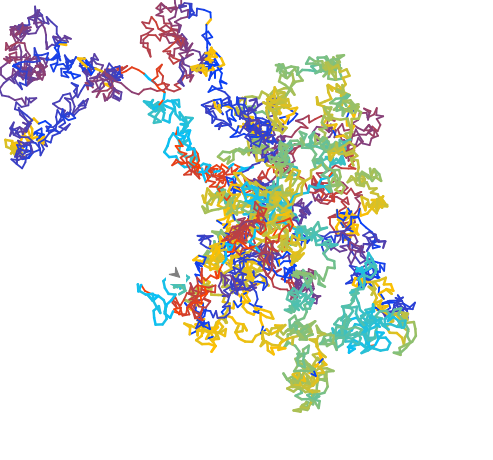Instructions for Objective 5.11 1. 5.11 Starter. Watch the video and think about the question. No need to type anything. 2. 5.11. Watch the videos and animations for the 3 models of Brownian Motion (for Model 3 you need to open the attached). Think about the questions. No need to type anything. 3. 5.11 explained. Check your understanding with the model answers. 4. 5.11 Questions. Forward this e-mail to your blog and complete the questions. 5. Answers to step 2 will be sent separately. Don’t look at them until you’ve done the work! 5.11 Starter 02 November 2011 16:58
>
· You're looking at smoke particles in air under a microscope
· They appear to be jiggling about
· Why?
· (Don't worry if you can't work this out straight away - Albert Einstein was the bloke who eventually explained what's happening here!) 5.11 28 October 2011 11:10
· 5.11 understand the significance of Brownian motion
> Model 1
· What does the red puck represent?
· What do the metal balls represent?
[cid:image001.png@01CC9989.A14EFF60]
[cid:image002.png@01CC9989.A14EFF60]
> Model 3
· What do the "smoke" particles look like?
· Why are they moving?
· What do the "air" particles look like? 5.11 explained 28 October 2011 11:10 Model 1
· What does the red puck represent?
o The large, visible smoke particle
· What do the metal balls represent?
o The small, not visible air particles Model 2
· What do the small red particles represent?
o The small, not visible air particles
· What does the large blue particle represent?
o The large, visible smoke particle
· What does the view on the left of the screen represent?
o The view through the microscope lense
· Why can‘t you see the red particles in this view?
o They are too small to see Model 3
· What do the "smoke" particles look like?
o They are the 5 large, sand coloured particles
· Why are they moving?
o Small, fast moving air particles are colliding with the smoke particles and making them move
· What do the "air" particles look like?
o They are the numerous, small, white particles 5.11 Questions 02 November 2011 17:21
1. Draw the path of a smoke particle in air (3 marks)
-> Random path (or 'random walk') similar to:
2. Explain what is meant by Brownian Motion of smoke particles in air and how it provides evidence for air particles (4 marks)
-> Brownian motion explains the phenomenon of visible smoke particles apparently 'jiggling' about, and traveling in random directions. These smoke particles are pushed in these random directions by the random collisions with small, fast moving air particles; this provides evidence for air particles as without the air particles, the smoke particles would not be 'jiggling about' but rather traveling in a more smooth manner.
3. What change would you expect to see in the movement of the smoke particles if the air was cooled down? Why? (2 marks)
-> I would expect the smoke particles to move less erratically, as the air particles would have less kinetic energy, meaning that there would be less collisions with the smoke particles to move them about (collision theory). The smoke particles would therefore still be moving, simply not as much.
>
· You're looking at smoke particles in air under a microscope
· They appear to be jiggling about
· Why?
· (Don't worry if you can't work this out straight away - Albert Einstein was the bloke who eventually explained what's happening here!) 5.11 28 October 2011 11:10
· 5.11 understand the significance of Brownian motion
> Model 1
· What does the red puck represent?
· What do the metal balls represent?
[cid:image001.png@01CC9989.A14EFF60]
[cid:image002.png@01CC9989.A14EFF60]
> Model 3
· What do the "smoke" particles look like?
· Why are they moving?
· What do the "air" particles look like? 5.11 explained 28 October 2011 11:10 Model 1
· What does the red puck represent?
o The large, visible smoke particle
· What do the metal balls represent?
o The small, not visible air particles Model 2
· What do the small red particles represent?
o The small, not visible air particles
· What does the large blue particle represent?
o The large, visible smoke particle
· What does the view on the left of the screen represent?
o The view through the microscope lense
· Why can‘t you see the red particles in this view?
o They are too small to see Model 3
· What do the "smoke" particles look like?
o They are the 5 large, sand coloured particles
· Why are they moving?
o Small, fast moving air particles are colliding with the smoke particles and making them move
· What do the "air" particles look like?
o They are the numerous, small, white particles 5.11 Questions 02 November 2011 17:21
1. Draw the path of a smoke particle in air (3 marks)
-> Random path (or 'random walk') similar to:
2. Explain what is meant by Brownian Motion of smoke particles in air and how it provides evidence for air particles (4 marks)
-> Brownian motion explains the phenomenon of visible smoke particles apparently 'jiggling' about, and traveling in random directions. These smoke particles are pushed in these random directions by the random collisions with small, fast moving air particles; this provides evidence for air particles as without the air particles, the smoke particles would not be 'jiggling about' but rather traveling in a more smooth manner.
3. What change would you expect to see in the movement of the smoke particles if the air was cooled down? Why? (2 marks)
-> I would expect the smoke particles to move less erratically, as the air particles would have less kinetic energy, meaning that there would be less collisions with the smoke particles to move them about (collision theory). The smoke particles would therefore still be moving, simply not as much.




No comments:
Post a Comment